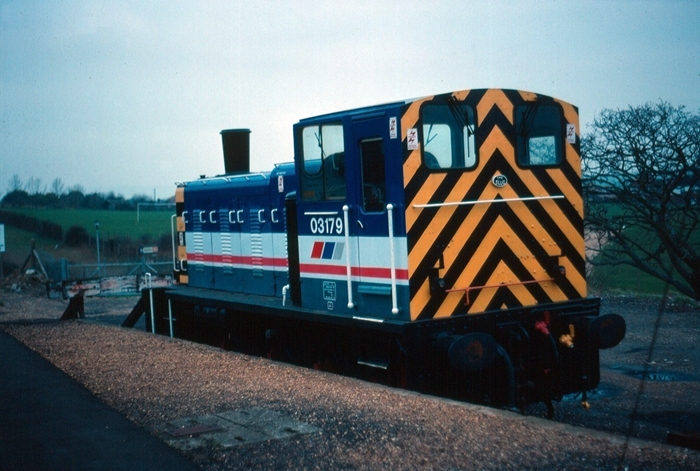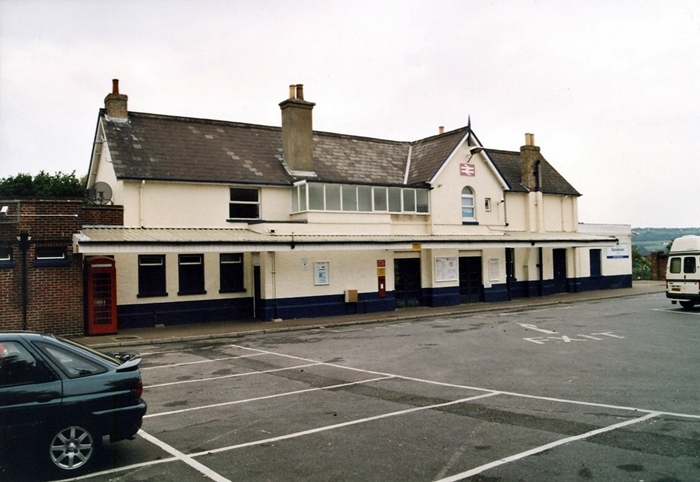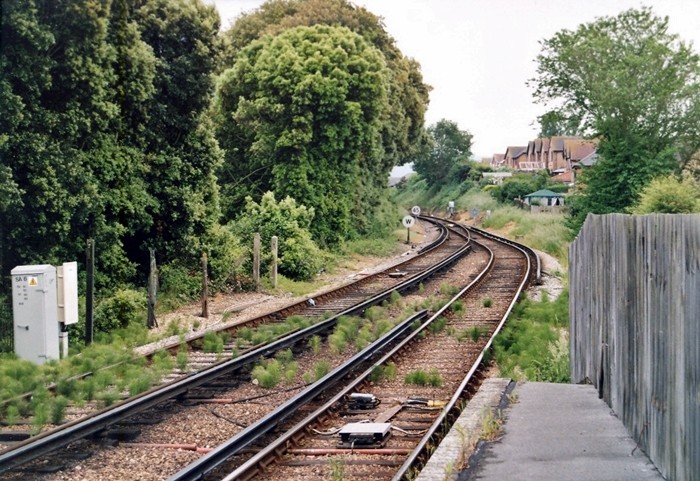
Sandown
Decline and Modernisation
Throughout the years, the highly seasonal nature of passenger traffic on the
island saw trains at bursting point during the summer, but the railway network
lied almost dormant in the winter months. Out of season, the sidings at Sandown
could be seen full of mothballed locomotives, which would come alive once again
when the holidaymakers returned. Unfortunately, in the earliest years of some of
those lines which crossed the island, peak season traffic was still not enough
to generate positive returns. Indeed, closure of lines under British Railways
auspices began with little delay:
Merstone to Ventnor West: 15th September 1952
Brading to Bembridge: 21st September 1953
Newport to Freshwater: 21st September 1953
Newport to Sandown: 6th February 1956
Sandown thus lost junction status, and it also appears that around the same
period, the huge building of 1893, south of the main station structure, was
razed to the ground. The small platform canopy which was sprouted from the
building was also demolished, but ten years of steam operation remained. By this
time, Cowes and Newport to Ryde, and Ryde to Ventnor, were the last operational
lines on the island. The Beeching Report, formally published on 27th March 1963,
included the closure of both routes. Fierce opposition to the proposals could
not prevent all intended cuts, but it was eventually agreed that the Ryde Pier
Head to Shanklin section of line could be retained, and this was confirmed by
the Minister of Transport in July 1965. Closures were thus:
Smallbrook Junction to Cowes: 18th February 1966
Shanklin to Ventnor: 18th April 1966
Goods traffic officially ceased at Sandown on 15th November 1965, and in the
same month, electrification of the Ryde Pier Head to Shanklin line was
authorised. Steam-hauled services continued between Ryde Esplanade and Shanklin
until 31st December 1966, after which the line was temporarily closed for
further electrification works to take place (third rail had already been laid by
this time). Pier Head station saw its last steam service on 17th September, and
had earlier closed for partial reconstruction to take place. As mentioned in the
Shanklin section, London Transport had made available redundant Northern City
Line Underground stock, which would be suitable for the restricted loading gauge
of the island’s remaining line. The tracks at stations were heightened to ensure
that the low floors of the Tube vehicles met the tops of the platforms, and
withdrawal of goods facilities allowed layouts to be simplified. The new
electric timetable came into effect on the re-opened line on 20th March 1967.
The former Newport platform loop at Sandown lost its southern connection with
the running line, and thereafter was retained as an engineers’ siding. A
truncated spur from the incoming branch did, however, remain a feature.
Double-track was retained between here and Brading, and Sandown’s signal box
controlled the single-track to Shanklin. At the latter, the signal box was
opened only at very busy periods in the high season, when both platforms at
Shanklin were brought into use. Electrification had been kind to Sandown, for
not only did it retain its main building and signal box, but both canopies, on
the ‘’down’’ side and ‘’up’’ island, remained complete. The retention of the
latter was perhaps a little surprising, given that the island had lost one
operational platform face on the conversion of the loop to a siding. Sadly,
further rationalisation did eventually occur, and in 1978 the island platform
lost its extensive, but crumbling, canopy. This was replaced by a glazed bus
shelter affair. The ‘’down’’ side canopy was severely pruned to bring it within
the limits of the main station building – exactly the same occurred at nearby
Shanklin. In 1988, work began on a re-signalling of the line, which would reduce
the Brading to Sandown section to single-track, and allow the signal box at the
latter to close, all control being transferred to the cabin at Ryde St Johns
Road. After 30th October 1988, Sandown signal box assumed the relegated status
of a ground frame: complete closure came on 25th March of the following year.
At the present time, consideration is being given to running steam services from
the Isle of Wight Steam Railway, into Ryde St Johns Road station. Network Rail
has stated this may be possible if the line’s passing loop is moved from Sandown
to Brading, which may see the former revert to its original 1864 state as a
single platform affair.
January 1990

Colourful Class 03 No. 03179 is seen stabled at the end of the engineers' siding, formerly the platform loop for
the Newport branch. This diesel shunter joined the permanent way department at Ryde St Johns Road in January
1989, and was in the company of a second Class 03, No. 03079. Both were sold back to the mainland in 1998,
No. 03079 being preserved and No. 03179 being purchased for use at Hornsey Depot, London. No. 03079 had
earlier arrived on the island in 1984, replacing Class 05 No. 97803. © David Glasspool Collection
13th June 2006

An obvious absence since the 1990 view is that of the signal box, but little else has changed. The engineers'
siding can be seen in the distance, trailing off the ''up'' line. A new entrance to the ''up'' platform had been
opened up by this time, and this emerges through the brown fence on the left, in the foreground. This saw
the shortening of the siding. © David Glasspool
13th June 2006

Like that at Shanklin, the main building of 1864 remains fully intact, complete with later additions made in about
1893. The headquarters of the Isle of Wight Railway, it is thought this company's main offices were in fact located
in a now demolished building formerly beyond the left extreme of this photograph. © David Glasspool
13th June 2006

A southward view shows the loop converging to single-track, which the line remains all the way to, and including,
Shanklin. This stretch of line was formerly controlled from Sandown signal box, but since 1988 has been signalled
from the cabin at Ryde St Johns Road. © David Glasspool
Return to the Kent Rail Homepage or alternatively, check for Updates.
Website & Copyright information - Links - Contact the Webmaster
All content is copyright © David Glasspool unless otherwise stated